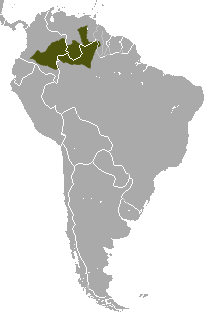Black titi monkey facts for kids
Quick facts for kids Black titi |
|
|---|---|
 |
|
| Conservation status | |
| Scientific classification | |
| Genus: |
Cheracebus
|
| Species: |
lugens
|
 |
|
| Black titi range | |
| Synonyms | |
|
Callicebus lugens Humboldt, 1811 |
|
The black titi monkey (Cheracebus lugens) is a small, furry New World monkey from South America. It is a type of titi monkey. You can find these monkeys living in parts of Brazil, Colombia, and Venezuela.
This species was first described in 1811. People sometimes call it the widow monkey because of its dark fur.
Contents
Where They Live
The black titi monkey lives in a very large area. It has the biggest home range of all Cheracebus species. They can be found from the Branco River and Rio Negro in the south. Their territory stretches north to the Orinoco River and Caqueta River basins.
These monkeys have been seen in places like La Macarena National Park in Colombia. They also live in the Vichada forest between the Vichada and Guaviare Rivers.
What They Look Like
Black titi monkeys are mostly black or dark brownish. They might have some reddish-brown hairs on their backs and sides. Their hands are usually white or yellowish.
How They Live
Black titi monkeys live in small family groups. A group usually has a mom and dad, who stay together for life. They also have one or two of their young. On average, a group has about 3 or 4 monkeys. Sometimes, you might see a group of five. Young monkeys usually leave their family group when they are about two years old.
Each family group has a special area they call home. This area is usually about 15 to 25 hectares big. Titi monkeys spend their days doing different things. They rest for most of the time, about half of the day. They also spend time moving, feeding, and grooming each other. They play a little bit and make sounds to talk to each other.
These monkeys are good at moving around in trees. They walk and run on all four legs most of the time. They are also very good at jumping between branches. They can climb well too. When they rest, they often sit or lie down.
What They Eat
Black titi monkeys mainly eat fruits. Fruits make up most of their diet. But they also eat other things like insects and leaves. They especially enjoy eating insect larvae, spiders, and other bugs. Sometimes, they might even eat small lizards.
They eat fruits from many different kinds of trees. One of their favorite foods is the fruit from the Jessenia polycarpa palm tree. They also eat fruits from trees like Virola and Ficus.
Having Babies
In some areas, black titi monkeys usually have their babies in December or early January. This time of year can be a bit hard because there is less fruit available. Scientists are still studying what foods help them have babies during this season.
Even in places with a lot of rain all year, the birth season is still around December. This is when some fleshy fruits start to become more common.
How They Talk
Black titi monkeys are very loving within their family. But they can be a bit aggressive towards other titi families nearby. The most common way they interact with neighbors is by singing. One pair will sing a duet, and then the other pair will sing back. They take turns singing to each other. Sometimes, these singing matches can lead to chases.
Their calls are very complex. They have a special "long-call" song that helps them mark their territory. It also helps them keep other groups away. If they hear a recording of another titi monkey singing, they might sing back. They might even move towards the sound to check it out.
Scientists think that titi monkeys can tell the sex of another monkey just by its long call. They might even be able to recognize individual monkeys by their singing.
Here are some of the sounds black titi monkeys make:
- Morning duet: This is the most common sound you will hear. The mom and dad sing together. It is a complex song used to defend their territory.
- Danger peep: These are soft, high-pitched sounds. They warn others about danger. It is hard to tell where these sounds come from.
- Purr: This sound is just like a cat's purr. All family members use it to show they are happy or want food, grooming, or a hug.
- Rough growl: Young monkeys make this sound when they are complaining, like about rain. They also use it when greeting adults.
- Sharp scream: They make this sound when they are fighting or very upset.
- Play growl: This is a low, gurgling sound used during play. It changes tone and ends with a questioning sound.
- Soft whine: Young monkeys often make this sound. Adults use it too when they want something, like food or grooming.
- Bark: This is a loud, sharp, and sudden bark. They make it when they are bothered by larger monkeys or birds of prey.
Black titi monkeys also use scent to communicate. Both males and females sometimes rub their chests with leaves. They wet the leaf with saliva and rub it up and down their throat and chest. They do this while looking up. This might be a way to mark their presence.
They also have special body movements called "displays":
- Piloerection: Their fur stands on end. This happens when they are excited, attacked, or feel threatened.
- Arched-back: They arch their back. This is a sign of aggression before an attack or when they feel threatened.
- Tail twinning: When a pair is singing or resting, they often wrap their tails around each other.
- Tongue flicking: They flick their tongue in two situations: when they are aggressive before an attack, or to reduce space with their mate.
- Chest rubbing: They rub their chest with a wadded leaf. This is done in front of humans and might show nervousness.
Young titi monkeys often play together. Adults and babies also play. While groups often sing to each other, sometimes fights can happen between neighboring families.
Who Are Their Enemies?
Black titi monkeys usually try to avoid larger monkey groups, like brown woolly monkeys or tufted capuchins. But sometimes, these small monkeys will bark loudly if the bigger ones get too close.
Titis are very careful around birds of prey, like eagles. They often hide from them. When they are scared, they make alarm peeps. This is because they need to be very alert to predators. A margay (a type of wild cat) was once found near a dead black titi. This shows that margays might hunt them.
What Is Their Status?
The black titi monkey is listed as a species of least concern on the IUCN Red List. This means they are not currently in danger of disappearing. They are protected in some national parks, like Chiribiquete National Park and El Tuparro National Park in Colombia. They are also found in the Nukak and Puinawai biological preserves.
See also
 In Spanish: Viudita para niños
In Spanish: Viudita para niños


